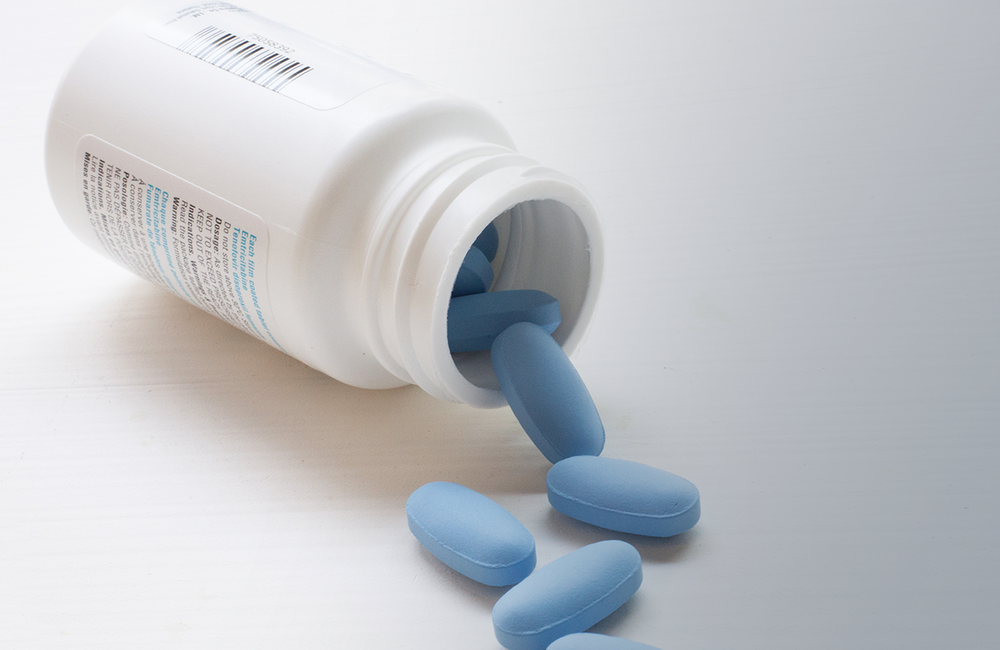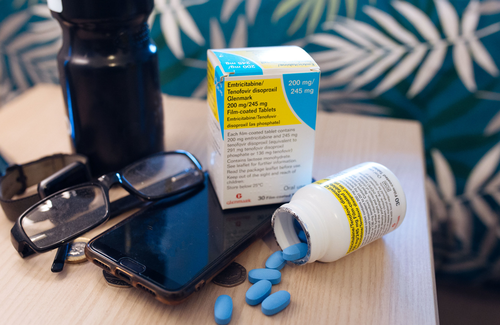
A US online survey has found that although gay and bisexual men who used PrEP had significantly more condomless sex with non-primary partners than men who didn’t use PrEP they were less likely to be anxious. A relationship seen in previous studies between higher rates of condomless sex and more anxiety did not seem to operate for PrEP users.
The survey
The survey was conducted by Dr Robert Moeller and colleagues from Middlebury College in Vermont. It recruited participants via a gay dating site and was only 'live' on a single weekend in 2016. Its findings therefore are already three years out of date, especially as there are now considerably more PrEP users in the US.
The researchers asked demographic questions, about use of PrEP and about sexual behaviour. They asked participants to complete three different validated questionnaires that are commonly used to measure depression, anxiety and internalised homophobia (self-stigma). The PHQ-9 and GAD-7 questionnaires (you can try them yourself if you click on the links) measure depression and anxiety respectively by asking respondents how many times in the last week they have experienced symptoms indicating either condition.
The IHP questionnaire for internalised homophobia asks people to what extent they agree with statements such as “I often feel it best to avoid personal or social involvement with other gay/bisexual men” and “I have tried to become more sexually attracted to women”.
Results – demographics and PrEP use
The researchers divided the 2406 men who answered the survey into four categories: HIV-negative PrEP users, comprising 11% of respondents; HIV-negative men who did not use PrEP (66%); HIV-positive men (11%); and men who did not know their HIV status (12%). The average age of participants was 34; HIV-positive men (average age 39) and PrEP users (average age 37) were older, and men of unknown status younger (average age 29).
Over half (55%) of respondents described themselves as white, 19% as Latino, 7% as black, and 5% as Asian or Pacific Islander. A disproportionate number of black men had HIV (19%). Asian and Pacific Islanders were much less likely to have HIV (4%) and had the highest rates of PrEP use (14%). Latino men were slightly more likely to have HIV (12%), and were much more likely not to know their HIV status (17%) – but were only half as likely as the average respondent to use PrEP (6%).
PrEP use was strongly tied to income. Only 5.5% of those earning under $20,000 a year were using PrEP versus 26% of all those earning over $100,000 a year, and 32% of the HIV-negative ones. Not knowing your HIV status was inversely tied to income, with 20% of those earning under $20,000 a year not knowing if they had HIV versus 5% of those earning over $100,000. Having tested HIV positive was not strongly associated with income.
Similarly, educational status was also linked to PrEP use. Only 6.5% of those with a high school diploma or less were using PrEP, compared with 17% of those with a postgraduate degree.
Perhaps surprisingly, 19% of men defining themselves as married took PrEP, versus 14% of those saying they were dating and 9.5% of those who were single. However, this was largely explained by PrEP use being concentrated among the 31% of married men and 36% of men who were dating who also said they were non-monogamous – and by the fact that not all single men were sexually active. The number of condomless anal sex casual partners during the last three months ranged from zero to 90, with an average number of 2.6.
There was a strong dichotomy in the number of casual condomless sex partners in the last three months between, on the one hand, PrEP users and HIV-positive men (average number respectively 5.5 and 5.2 partners) and, on the other hand, men who did not know their status and HIV-negative men not on PrEP (respectively 1.9 and 1.6 partners).
Results – mental health
"PrEP users had the best mental health of all the respondents, by all three conditions measured (depression, anxiety and self-stigma)."
In gay and bisexual men, anxiety and depression are roughly twice as common as they are among heterosexual men, with various US surveys reporting 41% suffering from mild to severe anxiety compared to 19% of heterosexual men.
Arguably the most striking finding of this survey is that PrEP users had the best mental health of all the respondents, by all three conditions measured (depression, anxiety and self-stigma).
Conversely, men who did not know their HIV status had the worst mental health, by all three measures. HIV-negative men not using PrEP and HIV-positive men had average, and similar, levels of mental health.
In the PHQ-9 depression scale, possible scores range from zero (not at all depressed) to 27 (maximally depressed). Scores over 5, 10, 15 and 20 are rated as mild, moderate, severe and very severe respectively.
In this survey, PrEP users scored 5.7, HIV-negative non-PrEP users 7.0, HIV-positive respondents 7.0 (all mildly depressed), and people who did not know their status 9.7, bringing them close to the 'moderately depressed' threshold.
For the GAD-7 anxiety scale, the maximum score is 21 and scores of over 5, 10 and 15 are classed as mild, moderate and severe anxiety. In this survey PrEP users scored 4.5, meaning they had no significant anxiety. HIV-negative non-PrEP users and HIV-positive respondents scored 5.4 and 5.5 respectively, and men who did not know their status 7.3, meaning they had mild anxiety.
For the internalised homophobia scale, nine questions were asked with possible scores of 1-5 each (from ‘don’t agree at all’ to ‘fully agree’), so minimum and maximum scores were 9 and 45. PrEP takers had the lowest average score at 15.1; HIV-positive men, interestingly, had the second-lowest scores at 16.4; HIV-negative non-PrEP users’ scores averaged 18.1; and men who did not know their status 20.6.
The researchers wanted to see if an association between PrEP use, condomless anal sex and either depression or anxiety remained significant in a regression analysis in which these three factors and self-stigma were progressively controlled for.
In particular, they wanted to see if PrEP use changed an association seen in this and other studies between higher rates of depression and anxiety and more condomless sex. This turned out to be the case for anxiety, but was not significantly so for depression.
There was certainly an association between more condomless sex and higher rates of depression and anxiety in all non-PrEP users. The average depression score in non-PrEP users who had no condomless casual sex partners in the last three months was 6.8 (out of a maximum 27), while it was 8.2 in those with 20 or more partners. With anxiety, the difference was even larger, with those reporting no condomless sex scoring 5.25 (out of a maximum 21) and those reporting 20 or more partners scoring 7.0.
(Note that this association can’t attribute causality to this link; people might be depressed or anxious because they were having more unprotected sex and were worried about their risk; equally, they could be having more unprotected sex as a coping behaviour because they were depressed or anxious.)
This association was far less marked for depression in PrEP users, with the depression score only increasing from 6.4 to 6.6 as the number of condomless casual sex partners changed from zero to 20. However, once the fourth factor – self-stigma – was fed into the regression analysis the link between PrEP use and lack of depression about condomless sex was no longer significant.
With anxiety, however, the link remained. PrEP users scored consistently below 5 on the anxiety scale regardless of how many condomless sexual partners they had had, and this remained unchanged by self-stigma.
Discussion
This was a relatively small survey and the difference in mental health scores between PrEP users and others, though consistent, were not especially large. The researchers note that a five-point decrease on the PHQ-9 and GAD-7 scales is regarded as a clinically significant improvement. Across a population, however, it may be important: for instance, the difference between men and women in such scales, despite mental ill-health being a strongly gendered condition, is generally in the region of one point.
Even though the differences were not large, the researchers emphasise the finding on anxiety: “While having a higher number of condomless-anal-intercourse partners is associated with increased anxiety among participants who are not on PrEP, whether HIV positive or HIV-negative, the use of PrEP seems to moderate this difference.”
They note that a number of other studies have found that depression, anxiety and internalised homophobia are all associated with greater HIV risk via condomless sex in gay men.
“These mental health burdens are frequently co-occurring and often function synergistically, as a syndemic,” they note, “[yet] our results indicate lower levels of mental health burden among PrEP users are related to significantly higher rates of condomless anal intercourse.”
“Syndemic” is a term that has been used to describe the way that pre-existing trauma, anxiety and depression, condomless and casual sex, chemsex and other drug use, the stigma of HIV itself, and societal disadvantage may all combine to greatly amplify the risk of HIV infection for certain members of already at-risk populations.
The syndemic idea explains why certain members of certain populations may be much more likely to risk and catch HIV than others. However, it also implies that it may be very difficult to break the vicious circle that may lead to HIV infection (or to other problems such as addiction).
The findings can be added to a series of qualitative studies which found reduced sexual anxiety in PrEP users and a previous quantitative study from Australia.
The researchers speculate that, although there might be other factors such as PrEP users having better access to mental health care, this is most likely because PrEP users (correctly, in the case of HIV) do not experience condomless anal intercourse as risky and that the link to anxiety about it is therefore broken.
They call for longer-term and longitudinal studies to tease out the causal direction of these changes in gay men’s mental health and risk behaviour in the era of PrEP.
Moeller RW et al. Use of PrEP, sexual behaviors and mental health correlates in a sample of gay, bisexual and other men who have sex with men. Journal of Gay and Lesbian Mental Health, 24: 94-111, January 2020.

